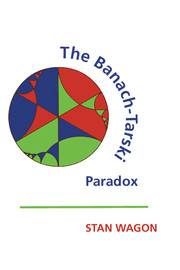Book contents
- Frontmatter
- Contents
- Foreword by Jan Mycielski
- Preface
- Preface to the Paperback Edition
- Part I Paradoxical Decompositions, or the Nonexistence of Finitely Additive Measures
- Part II Finitely Additive Measures, or the Nonexistence of Paradoxical Decompositions
- Appendix A Euclidean Transformation Groups
- Appendix B Jordan Measure
- Appendix C Unsolved Problems
- Addendum to Second Printing
- References
- List of Symbols
- Index
Foreword by Jan Mycielski
Published online by Cambridge University Press: 05 August 2012
- Frontmatter
- Contents
- Foreword by Jan Mycielski
- Preface
- Preface to the Paperback Edition
- Part I Paradoxical Decompositions, or the Nonexistence of Finitely Additive Measures
- Part II Finitely Additive Measures, or the Nonexistence of Paradoxical Decompositions
- Appendix A Euclidean Transformation Groups
- Appendix B Jordan Measure
- Appendix C Unsolved Problems
- Addendum to Second Printing
- References
- List of Symbols
- Index
Summary
This book is motivated by the following theorem of Hausdorff, Banach, and Tarski: Given any two bounded sets A and B in three-dimensional space R3, each having nonempty interior, one can partition A into finitely many disjoint parts and rearrange them by rigid motions to form B. This, I believe, is the most surprising result of theoretical mathematics. It shows the imaginary character of the unrestricted idea of a set in R3. It precludes the existence of finitely additive, congruence-invariant measures over all bounded subsets of R3 and it shows the necessity of more restricted constructions such as Lebesgue's measure.
In the 1950s, the years of my mathematical education in Poland, this result was often discussed. J. F. Adams, R. M. Robinson, and W. Sierpiński wrote about it; my Ph. D. thesis was motivated by it. (All this is referenced in this monograph.) Thus it is a great pleasure to introduce you to this book, where this striking theorem and many related results in geometry and measure theory, and the underlying tools of group theory, are presented with care and enthusiasm. The reader will also find some applications of the most recent advances of group theory to measure theory — work of Gromov, Margulis, Rosenblatt, Sullivan, Tits, and others.
But to me the interest of mathematics lies no more in its theorems and theories than in the challenge of its surprising problems.
- Type
- Chapter
- Information
- The Banach-Tarski Paradox , pp. xi - xiiPublisher: Cambridge University PressPrint publication year: 1985

